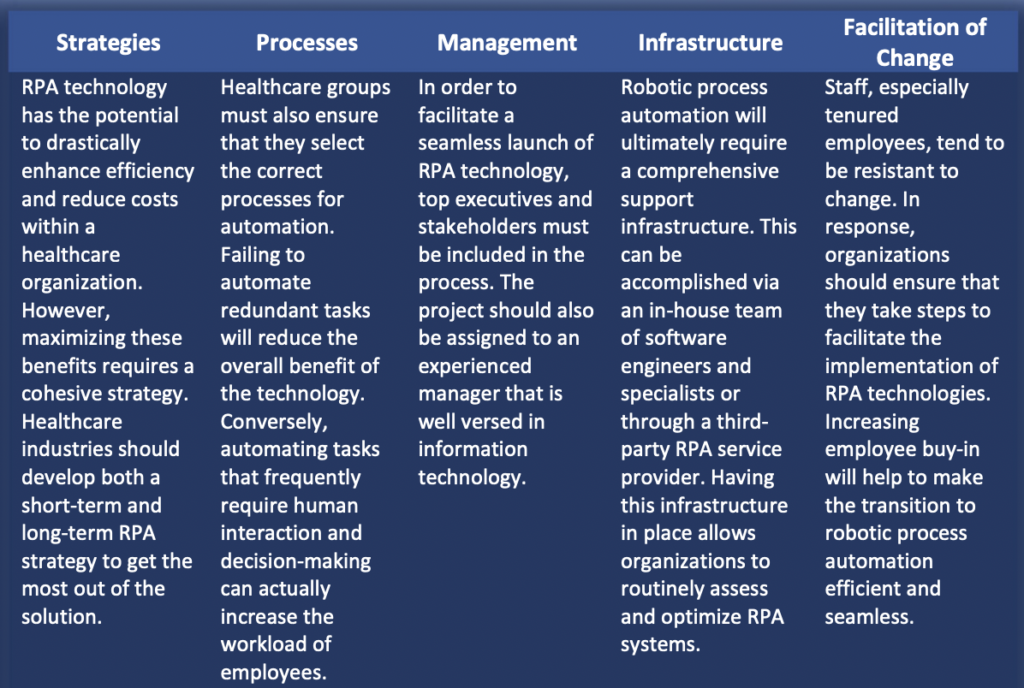The creation and development of robotic process automation (RPA) has had a tremendous impact on various industries over the last few years. While companies in all sectors have benefited from this technology, RPA has been particularly useful for healthcare revenue cycle management (RCM).
Healthcare organizations like hospitals, physicians’ groups, and other entities have effectively implemented RPA to remove
redundancies and improve the patient care experience. Implementing robotic process automation technologies is a valuable cost-saving measure that simultaneously reduces the risk of human input errors.
Moving forward, RPA is positioned to be an integral part of the healthcare industry as a whole, due to its versatility and a wealth of potential benefits when compared to traditional automation processes.
What Is RPA?
Robotic process automation is a specific form of automation technology that leverages bots to complete various tasks that had previously been performed manually.
While the term “RPA” has been used for a few decades, it has only recently been applied to revenue cycle management. In addition to the healthcare sector, robotic process automation is widespread in manufacturing and the food and beverage industry.
Without a doubt, robotic process automation for revenue cycle management is changing the landscape of the healthcare industry.
During claims processing and billing, a single error can cost an organization hundred of wasted labor hours and might even result in payments being denied. RPA virtually eliminates this risk of error, thereby helping healthcare organizations to operate at peak efficiency. RPA can also be implemented for charting and scheduling purposes, further refining the care process.

When discussing RPA, it is important to differentiate it from artificial intelligence (AI). While RPA automates many different processes, a human is still responsible for monitoring these technologies to a certain extent.
Conversely, AI utilizes machine learning to evolve continuously. AI can follow a workflow to navigate through various solutions on its own, whereas RPA takes over repetitive processes so that employees can focus on more dynamic, decision-oriented, and patient-focused tasks.
How RPA Works
Before robotic process automation solution can be successfully implemented, organizations must identify scenarios that necessitate human interaction.
Since RPA does not include reasoning and decision-making functionalities, any tasks that require these attributes should be left to humans. By establishing clear boundaries for RPA technology, organizations will be able to integrate it into their existing workflows seamlessly.
An RPA engineer or third-party robotic process automation provider will assess an organization’s needs. They typically will then create specific rules within an RPA platform so that it can handle the desired tasks. When preparing to roll out RPA technologies for RCM, healthcare organizations must consider the following:

Traditional Automation vs. Robotic Process Automation
At first glance, the variation between traditional automation and RPA may seem minuscule. However, there are actually substantial differences between the two technological solutions.
When implementing traditional automation, organizations have to alter the back-end of their platforms while also making changes to the front-end. While it is possible to make a machine handle any redundant task, integrating traditional automation software could be incredibly time-consuming and costly. Conversely, RPA focuses entirely on the front-end, which allows IT teams to implement the technology
efficiently.
The reason for this variation is that RPA interacts with an organization’s systems much like a human employee would. Due to the nature of RPA interactions, the technology can be integrated into multiple application types with ease. RPA is also scalable and much more cost-effective than traditional automation.
Is RPA Better than Traditional Automation?
In many instances, robotic process automation is a better option for organizations than traditional solutions. However, RPA has by no means made traditional automation technologies obsolete.
Each option is a strong choice for specific purposes. With that said, RPA is a more viable technology for revenue cycle management and many other healthcare-related processes. RPA provides organizations with a personalized solution that can be rapidly rolled out. Robotic process automation is particularly appealing to healthcare organizations because it can access
multiple applications from the front end. Since nearly all hospitals and other healthcare providers utilize a suite of applications to provide patient care, the flexibility of RPA makes it the better option overall.
Traditional automation is required when massive amounts of data need to be transferred between two or more systems. This is because RPA works within the limitations of a platform’s user interface. Robotic process automation solutions are only able to input data as fast as the RCM platform can receive it.
Tangible Benefits of RPA for RCM
Robotic process automation is quickly becoming a staple of the healthcare industry, especially for revenue cycle management. This is because RPA offers substantial benefits when compared to manual data entry practices.
With RPA, healthcare organizations can affect positive change with everything from billing practices to the patient care experience.
The advantages of RPA for RCM include:
Removing the Robotic Component from the Human Element
Robotic process automation expert Om Sharma, SVP of Business Excellence at GeBBS Healthcare Solutions, is fond of saying, “RPA removes the robot from the human and provides a working experience without errors to the human.” A digital work force alongside humans/users. Put simply, RPA mimics the part of the human brain that can complete redundant, stable tasks
such as data entry. However, RPA systems improve upon manual data entry by eliminating the risk of errors.
According to Sharma, the RPA “robot is able to do your ABCs 100% accurately every time,” whereas even top employees have some margin of error. By controlling for errors, RPA technology provides a clear advantage over manual data entry for RCM.
Improving Results
Robotic processing automation also improves overall business results. This is because it frees up employees to focus on high-priority activities related to billing and patient care. RPA can create notable improvements to an organization’s bottom line.
For instance, medical coding professionals could spend more time reviewing complex cases and obtaining information from various providers. Once that RCM data is received, the RPA program could handle the redundant processes.

Cutting Costs
Another substantial advantage of RPA is that it cuts the cumulative costs of wages for healthcare organizations. By automating
redundant processes with highly efficient robotics software, employers can save thousands of dollars. This is because fewer
employees will be required to oversee RCM processes.
While RPA will clearly make some staffing positions obsolete, employers have the opportunity to reallocate many employees to
new posts. For instance, existing staff members can be cross trained to perform other functions or upskilled to take on a larger role within the organization. Upskilling employees is the most appealing option for many companies because it allows them to
further maximize cost savings. Recruiting and training new hires is incredibly expensive.
Once an RPA system is fully operational, organizations will have the opportunity to begin teaching data entry personnel these new skills. The employees are more likely to have a strong sense of loyalty to the company when senior-level staff has invested in their careers instead of simply letting them go.
Reducing Risks
Massive system overhauls tend to be extremely expensive and almost always exceed budgetary limits due to unexpected issues during the integration process. Unfortunately, these types of large-scale upgrades are necessary when implementing traditional automation technologies.
Once again, in this arena, RPA software demonstrates its incredible value and flexibility. Healthcare organizations can integrate RPA solutions into existing client management and RCM platforms because it only interacts with the “front-end.” The front-end of software refers to the functionalities and windows with which the user interacts. RPA projects present minimal risks to healthcare organizations. It is extremely easy to calculate the costs of implementation in advance and stay within a set budget.
Robotic process automation software can be implemented quickly, too. Once a sound transition plan is in place, RPA engineers can complete the entire process in a few weeks or less. By comparison, traditional automation often takes months and includes a high risk of disturbing a healthcare organization’s existing platforms.
Reduction of Data Entry Errors
Healthcare organizations across the country have seen a notable decline in data entry errors after implementing RPA software. When completing redundant tasks, even the most dedicated and skillful employees are prone to distraction. These momentary lapses in focus often result in data entry errors.
However, RPA bots never lose focus on the task at hand. They consistently enter data with 100% accuracy. By eliminating these errors, organizations can also improve the patient experience. Patients will no longer receive incorrect billing statements or treatment summaries. Eliminating errors can also provide benefits that trickle down to other employees. Once an organization has eliminated data entry errors through RPA, customer service staff will have a reduced workload. When a patient does require service, these staff members will be able to provide them with more individualized solutions.
With that being said, RPA services should be reviewed periodically. This vetting process ensures that the RPA software is working as designed and isn’t experiencing any malfunctions. If an error does occur, it is likely the result of a programming issue that assigned inappropriate responsibilities to the RPA system.
Rapid Service
Through the power of RPA systems, healthcare service providers can provide a streamlined care experience for their patients. Appointments will no longer be delayed due to back-office procedures, such as processing a claim or entering rudimentary treatment data. Instead, support staff can spend more time interacting with patients while the RPA solutions
complete redundant tasks.
High Data Quality
Robotic process automation provides organizations with high-quality data due to the elimination of manual data entry errors.
Executives and stakeholders will be able to use this data to access a more accurate analysis of key metrics. This analytics data can be leveraged to refine business practices and make the organization more efficient as a whole.
Leveraging a Wider Range of Data
RPA does not only improve the accuracy of analytics data; the technology also gives healthcare organizations access to a broader array of information.
RPA bots have the ability to interact with all of the systems that a healthcare organization uses. These bots can uncover data that is buried deep within these legacy systems and extract it for analysis.
Without RPA technology, most of this valuable data would remain undiscovered. Uncovering this information takes hours of manual labor when assigned to human employees.
Reducing Total Workload
RPA solutions free up data entry staff, but analytics departments also reap the benefits of a reduced workload. They will no longer waste hours mining data and reviewing information that was entered manually.
Instead, they can engage in more complex data analysis that leverages 100% accurate information. While analytics are an essential tool for all modern businesses, they are especially vital for healthcare organizations that are trying to optimize RCM.
Improving Employee Morale Redundant tasks, such as copying patient data from one platform to another, are detrimental to employee morale. When staff members experience a dip in morale, their job performance decreases. This reduced job performance makes data entry errors much more likely, which can be extremely detrimental to RCM and an organization’s profitability, producing a vicious cycle. Implementing RPA systems into healthcare organizations provides an immediate boost to
employee morale. Not only will staff members experience a reduced workload, but they will also have the opportunity to work on dynamic tasks. They will face new and unique challenges each day, which will improve their overall level of engagement and job performance.
Enhancing Retention Rates
Higher employee morale can also improve retention rates. Each vacancy that an organization carries can cost them hundreds of dollars per day in lost productivity. On the other hand, hiring a single employee requires thousands of dollars in recruiting and training expenses. Robotic process automation allows employers to reduce churn rate and retain talented staff members. In addition, teams can be kept lean because redundant tasks are automated. This means that managers will be responsible for supervising a smaller and more satisfied group of staff members.
Reducing Hiring Costs and Boosting Brand Reputation
Through online platforms such as Indeed, LinkedIn, and Glassdoor, employees are able to share their work experiences. If a healthcare organization has a widespread morale issue that is caused by a lack of automation and a reputation for overworking employees, brand image will suffer. Implementing RPA indirectly enhances an organization’s brand reputation and also reduces hiring costs. Prospective candidates will be eager to apply for open positions, which means that the company will not have to allocate as many resources towards advertising job opportunities. Healthcare organizations will be able to attract and retain top talent, partly thanks to RPA systems.
Avoiding Risk and Compliance Issues
The healthcare industry is one of the most heavily regulated industries in the United States. This is because providers have access
to confidential patient data and health histories.
While having access to this information is necessary to facilitate care and conduct RCM processes, it also makes healthcare organizations prime targets for cyberattacks. Cybersecurity threats have become more common and complex in recent years. These attacks have been perpetrated with increasing frequency, which is why protecting patient data must be
a priority for modern healthcare organizations.
Even though robotic process automation is not a cybersecurity measure on its own, it does indirectly reduce the risk of encountering compliance issues. By automating redundant processes, healthcare organizations reduce the total number of staff members that have access to patient data.
Minimizing human interaction with patient data through an RPA system means that hackers have fewer avenues by which they can gain access to a healthcare organization’s network. Many cyberattacks are successful due to an employee’s error, which is why RPA technology can be a great addition to dedicated cybersecurity protocols.
RPA software can also help healthcare organizations to avoid fines as the result of compliance violations. This technology allows staff to conduct detailed audits in the event that an issue arises.
The ability to create a traceable audit trail can be a valuable asset to healthcare organizations, all while supplementing the many other cost-saving benefits of RPA technology.
RCM Tasks that Can Be Allocated to RPA Systems
RPA can be utilized for a broad range of revenue cycle management-related tasks. While it cannot fully replace the human ability to reason or perform dynamic functions, it can streamline duties such as:
Preauthorization
Manual preauthorization can cause lengthy delays to the patient care process. Employees may get sidetracked with other responsibilities or get placed on hold for an extended period, leaving them unable to complete the preauthorization process.
RPA can be used to handle redundant aspects of the preauthorization process, like inputting data about prescribed treatments or medications. This allows the care team to quickly submit the data to insurance providers so that it can be approved.
Insurance Verification
Insurance verification is also an incredibly tedious and redundant process that wastes countless person-hours. Automating this task with RPA systems will improve the patient experience and allow patients to rapidly receive the care they require. In addition, employees will no longer need to be tied up waiting on a response from insurance companies. Instead, they can get back to serving other patients and completing more complex tasks.

Claims Submission
Claims submission is an essential part of the RCM process. However, data entry errors during claims submission can result in providers not receiving payment for services rendered. RPA eliminates the risk of mistakes and facilitates prompt claims processing.
Patient Billing
Improperly entering patient billing details can create additional work for customer service representatives. Data entry personnel may also have to go back and locate the error so that it can be remedied. The result? Several staff members may be tied up for hours due to a single data entry error.
All of this waste can be avoided by implementing RPA for RCM technology.
Robotic Process Automation: The Future of RCM
Robotic process automation provides many benefits to healthcare organizations, particularly when it comes to revenue cycle management. Top healthcare organizations are already leveraging automation to improve the patient care experience, eliminate data entry errors, improve efficiency, and reduce expenses. This should come as no surprise, due to the tremendous advantages of RPA when compared to manual data entry. RPA technology can be implemented at a relatively minimal cost while adding incredible value to the RCM process.
GeBBS Healthcare Solutions is the premier RPA option for healthcare organizations. We are the leading national provider of both revenue cycle management and health information management solutions.
GeBBS provides strategic outsourcing solutions to medical billing companies and healthcare providers. By leveraging our people, processes, and technology, we enable clients to reduce operating and capital costs, recover revenue, improve patient satisfaction, and increase productivity. With unparalleled expertise in the healthcare industry, we can provide end-to-end solutions for your
billing challenges while simultaneously supporting your overall business operations. Contact us today to request a consultation with one of our knowledgeable experts to learn how GeBBS can help you put RPA to work for your RCM processes.






